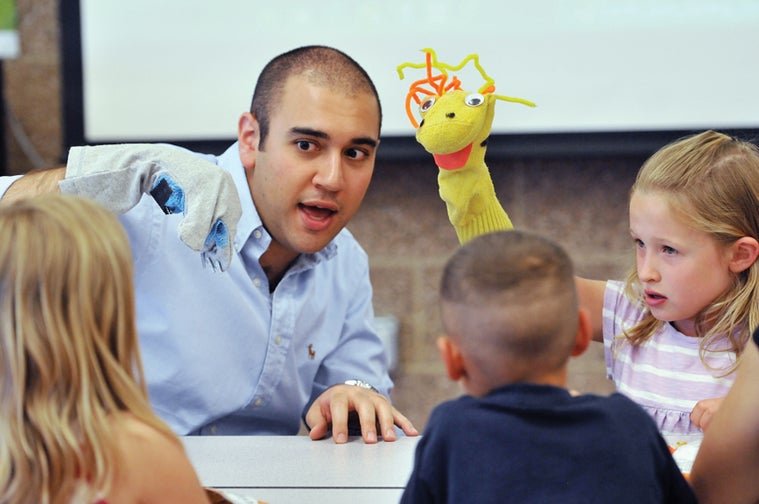
CU-Boulder student David Rahmani works with children at Columbine Elementary School in Boulder as part of his Science, Technology, Engineering and Math (STEM) education.
In an after-school class of budding scientists, planting vegetable seeds becomes a lesson in how plants grow, cleverly disguised as an afternoon of playing in the dirt.
Amid colorful hand-drawn posters announcing that Franklin, the school’s pet turtle, is missing, 15 five- to eight-year-olds crowd around a table cluttered with seed packets, bags of soil and three-inch cups in the cafeteria at Columbine Elementary School in Boulder.
After-school teaching assistant David Rahmani places trays of planted seeds in a sunny window overlooking the school playground, so students can follow the plants’ progress.
Responding to concerns that American students lack adequate skills to compete in a technologically complex global economy, Rahmani is part of a growing number of CU-Boulder students who are putting a fresh face on how math and science classes are taught on and off campus. As a national leader in STEM education, the university’s effort involves more than 45 programs in 14 departments.
And it is beginning to transform the way college undergraduates and graduates are taught, boosting the number of students pursuing teaching careers, improving STEM education in K-12 classes and expanding informal school-based educational programs.
For Rahmani, a 23-year-old graduate physics student, it means teaching once a week at Columbine and collaborating with colleagues to engage youngsters in science.
“Sometimes playing in the dirt is learning about the dirt, too,” Rahmani says. “It’s about getting students to make connections between their lives and the world around them in a scientific manner.”
Making these scientific connections can be elusive. Students in the United States rank 25th in math and 21st in science compared to students in 30 industrialized countries. Even our top math students rank 25th out of 30 when compared to the best students around the globe. Top countries include China, Korea, Finland, Japan and Switzerland, according to a Programme for International Student Assessment study, says physics professor Noah Finkelstein who directs STEM education on campus.
For the United States to be an international leader addressing tough scientific and technological challenges, educators must do a better job of encouraging students to pursue careers in science, technology, engineering and math. This is why students-turned-teachers and after-school facilitators like Rahmani play a crucial role.
“The university is the focal point for helping shift the national dialogue about STEM education and to address key challenges,” says Finkelstein, noting the large-scale initiative has the potential to dramatically improve the quality of education.
Because of a five-year collaboration with the education school, arts and sciences college and the engineering and applied science college, the university has doubled the number of undergraduates in STEM-related majors who complete secondary math and science teacher certification, averaging more than 13 annually.
And while 13 may seem low, it underscores the challenges inherent in successfully recruiting students who are strong in science into teaching.
“There’s a great need for STEM teachers in K-12, but it’s challenging to attract STEM college students to become teachers because the pay differential compared to industry is so large,” says CU-Boulder assistant professor Jeremy Siek of electrical, computer and energy engineering who received an early career award from the National Science Foundation for effectively integrating research and education in his work.
To build success, more than 440 students have participated as learning assistants, helping improve introductory courses in 10 departments from physics to astrophysical and planetary sciences since the program began in 2003.
Rahmani credits CU-Boulder’s initiatives for helping transform how math and science are taught so the excitement of deep understanding is accessible to students of all ages.
“I joke about teaching freshman physics to kindergartners,” says Rahmani, “but if we get them excited about science now, we can build on that, so 10-15 years from now they’ll still be interested in science.”
No word yet on the whereabouts of Franklin the turtle, but perhaps a biology-savvy elementary student will help locate him.
Read more on STEM education at www.colorado.edu/istem.
Photo courtesy Casey A. Cass






